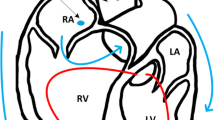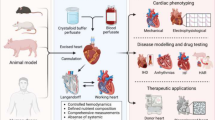Abstract
Cardiovascular research employs a milieu of experimental models to investigate various conditions of health and disease ranging from cellular and whole organ preparations to computer modeling simulations. Uniquely, the isolated perfused heart model allows for the separation of cardiac and systemic variables, yet one can still explore typical measures used in cardiac research including myocardial function, metabolism, and/or responses to pharmacological, mechanical, and electrical components. A survey of the literature reveals that such preparations can vary greatly in design including choice of animal model, perfusion modes, perfusate compositions, and/or procedural techniques. Further, the wide array of measurements are made in the denervated heart, allowing one to conduct research in the absence of the confounding effects of sympathetic and vagal stimulations. Recently, there have been several groups employing high-resolution imaging and monitoring technologies to gain further insight into the intracardiac environment and/or the impact of various surgical procedures and implant techniques on the device–tissue interface. This chapter summarizes the major methodologies used to support these models, provides examples of usage, and clarifies the advantages and disadvantages of isolated hearts in comparison with other types of cardiovascular research.
Access this chapter
Tax calculation will be finalised at checkout
Purchases are for personal use only
Similar content being viewed by others
References
Langendorff O. Untersuchungen am uberlebenden Saugethierherzen (Investigations on the surviving mammalian heart). Arch Gesante Physiol 1895; 61:291–332.
Hearse DJ, Sutherland FJ. Experimental models for the study of cardiovascular function and disease. Pharmacol Res 2000; 41:597–603.
Neubauer S, Ingwall JS. The isolated, buffer-perfused ferret heart: a new model for the study of cardiac physiology and metabolism. Lab Anim 1991; 25:348–53.
Jacob AD, Elkins N, Reiss OK, et al. Effects of acetate on energy metabolism and function in the isolated perfused rat heart. Kidney Int 1997; 52:755–60.
Coetzee A, Kotze J, Louw J, et al. Effect of oxygenated crystalloid cardioplegia on the functional and metabolic recovery of the isolated perfused rat heart. J Thorac Cardiovasc Surg 1986; 91:259–69.
McCarthy PM, Fukamachi K, Fukumura F, et al. The Cleveland Clinic-Nimbus total artificial heart. In vivo hemodynamic performance in calves and preclinical studies. J Thorac Cardiovasc Surg 1994; 108:420–8.
Von Scheidt W, Neudert J, Erdmann E, et al. Contractility of the transplanted, denervated human heart. Am Heart J 1991; 121:1480–8.
Quill JL, Laske TG, Hill AJ, et al. Direct visualization of a transcatheter pulmonary valve implantation within the visible heart: a glimpse into the future. Circulation 2007; 116:e548.
Hill AJ, Ahlberg SE, Wilkoff BL, et al. Dynamic obstruction to coronary sinus access: the Thebesian valve. Heart Rhythm 2006; 3:1240–1.
Anderson SE, Skadsberg ND, Laske TG, et al. Variation in pacing impedance: impact of implant site and measurement method. Pacing Clin Electrophysiol 2007; 30:1076–82.
Love CJ, Ahlberg SE, Hiniduma-Lokuge P, et al. Novel visualization of intracardiac pacing lead extractions: methodologies performed within isolated canine hearts. J Interv Card Electrophysiol 2009; 24:27–31.
Laske TG, Skadsberg ND, Iaizzo PA. A novel ex vivo heart model for the assessment of cardiac pacing systems. J Biomech Eng 2005; 127:894–8.
Chinchoy E, Soule CL, Houlton AJ, et al. Isolated four-chamber working swine heart model. Ann Thorac Surg 2000; 70:1607–14.
Hill AJ, Laske TG, Coles JA Jr, et al. In vitro studies of human hearts. Ann Thorac Surg 2005; 79:168–77.
Sigg, DC, Coles JA Jr, Gallagher WJ, et al. Opioid preconditioning: myocardial function and energy metabolism. Ann Thorac Surg 2001; 72:1576–82.
Coles JA Jr, Sigg DC, Iaizzo PA. The potential benefits of 1.5% hetastarch as a cardioplegia additive. Biochem Pharmacol 2005; 69:1553–8.
Liu CT. Techniques for isolation and performance of the perfused guinea pig working heart. Am J Vet Res 1986; 47:1032–43.
Glower DD, Spratt JA, Snow ND, et al. Linearity of the Frank-Starling relationship in the intact heart: the concept of preload recruitable stroke work. Circulation 1985; 71:994–1009.
Neely JR, Libermeister H. Effect of pressure development on oxygen consumption by an isolated rat heart. Am J Physiol 1967; 212:804–14.
Fragata JI, Areias JC. Acute loads applied to the right ventricle: effect on left ventricular filling dynamics in the presence of an open pericardium. Pediatr Cardiol 1996; 17:77–81.
Schafer S, Schlack W, Kelm M, et al. Characterisation of left ventricular -dp/dt in the isolated guinea pig heart. Res Exp Med 1996; 196:261–73.
Hess OM, Bhargava V, Ross J Jr, et al. The role of the pericardium in interactions between the cardiac chambers. Am Heart J 1983; 106:1377–83.
Araki Y, Usui A, Kawaguchi O, et al. Pressure-volume relationship in isolated working heart with crystalloid perfusate in swine and imaging the valve motion. Eur J Cardiothorac Surg 2005; 28:435–42.
Hasegawa H, Araki Y, Usui A, et al. Mitral valve motion after performing an edge-to-edge repair in an isolated swine heart. J Thorac Cardiovasc Surg 2008; 136:590–6.
Bowditch HP. Über die Eigenthümlichkeiten der Reizbarkeit, welche die Muskelfasern des Herzens ziegen. Berichte über die Verhandlungen der Königlich Sächsischen Gesellschaft zu Leipzig. Mathematisch-Physische Classe 1871; 24:652–89.
Banville I, Chattipakorn N, Gray RA. Restitution dynamics during pacing and arrhythmias in isolated pig hearts. J Cardiovasc Electrophysiol 2004; 15:455–63.
Barold S, Lau C-P. Primary prevention of heart failure in cardiac pacing. Pacing Clin Electrophysiol 2006; 29:217–9.
Manolis A. The deleterious consequences of right ventricular apical pacing: time to seek alternate site pacing. Pacing Clin Electrophysiol 2006; 29:298–315.
Steinberg JS, Fischer A, Wang P, et al.; MADIT II Investigators. The clinical implications of cumulative right ventricular pacing in the multicenter automatic defibrillator trial II. J Cardiovasc Electrophysiol 2005; 16:359–65.
Schwaab B, Fröhlig G, Alexander C, et al. Influence of right ventricular stimulation site on left ventricular function in atrial synchronous ventricular pacing. J Am Coll Cardiol 1999; 33:317–23.
Lee MA, Dae MW, Langberg JJ, et al. Effects of long-term right ventricular apical pacing on left ventricular perfusion, innervation, function and histology. J Am Coll Cardiol 1994; 24:225–32.
Laske TG, Skadsberg ND, Hill AJ, et al. Excitation of the intrinsic conduction system through His and interventricular septal pacing. Pacing Clin Electrophysiol 2006; 29:397–405.
Rosenqvist M, Bergfeldt L, Haga Y, et al. The effect of ventricular activation sequence on cardiac performance during pacing. Pacing Clin Electrophysiol 1996; 19:1279–87.
De Cock CC, Giudici MC, Twisk JW. Comparison of the haemodynamic effects of right ventricular outflow-tract pacing with right ventricular apex pacing. Europace 2003; 5:275–8.
Skadsberg ND, Coles JA, Iaizzo PA. Electrophysiologic assessment of right ventricular cardiac pacing sites employing non-contact electrical map**. IJBEM 2007; 7:325–8.
Hasegawa H, Araki Y, Usui A, et al. Mitral valve motion after performing and edge-to-edge repair in an isolated swine heart. J Thorac Cardiovasc Surg 2008; 136:590–6.
Mihaljevic T, Ootaki Y, Robertson JO, et al. Beating heart cardioscopy: a platform for real-time, intracardiac imaging. Ann Thorac Surg 2008; 85:1061–6.
Iaizzo PA, Hill AJ, Laske TG. Cardiac device testing enhanced by simultaneous imaging modalities: the Visible Heart®, fluoroscopy, and echocardiography. Expert Rev Med Devices 2008; 5:51–8.
Hill AJ, Iaizzo PA. Comparative cardiac anatomy. In: Iaizzo PA, editor. The Handbook of Cardiac Anatomy, Physiology and Devices, 2nd edition. New York: Humana Press, 2009 (Chapter 6).
Demmy TL, Magovern GJ, Kao RL. Isolated biventricular working rat heart preparation. Ann Thorac Surg 1992; 54:915–20.
Klima U, Guerrero JL, Levine RA, et al. A new, biventricular working heterotopic heart transplant model: anatomic and physiologic considerations. Transplantation 1997; 64:215–22.
Igic R. The isolated perfused “working” rat heart: a new method. J Pharmacol Toxicol Methods 1996; 35:63–7.
Bove AA, Santamore WP. Ventricular interdependence. Prog Cardiovasc Dis 1981; 23:365–88.
Forty J, White DG, Wallwork J. A technique for perfusion of an isolated working heart to investigate hyperacute discordant xenograft rejection. J Thorac Cardiovasc Surg 1993; 106:308–16.
Dunning J, Pierson RN, Braidley PC, et al. A comparison of the performance of pig hearts perfused with pig or human blood using an ex-vivo working heart model. Eur J Cardiothorac Surg 1994; 8:204–6.
Van Rijk-Zwikker GL, Schipperheyn JJ, Huysmans HA, et al. Influence of mitral valve prosthesis or rigid mitral ring on left ventricular pump function. Circulation 1989; 80:1–7.
Kimose H, Ravkilde J, Helligso P, et al. Influence of pre-existing ischemia on recovery from chemical cardioplegia. A study on pig hearts in an isolated blood-perfused model. Scand J sssssThorac Cardiovasc Surg 1992; 26:23–31.
Sandhu R, Diaz RJ, Wilson GJ. Comparison of ischaemic preconditioning in blood perfused and buffer perfused isolated heart models. Cardiovasc Res 1993; 27:602–7.
Weng ZC, Nicolosi AC, Detwiler PW, et al. Effects of crystalloid, blood, and University of Wisconsin perfusates on weight, water content, and left ventricular compliance in an edema-prone, isolated porcine heart model. J Thorac Cardiovasc Surg 1992; 103:504–13.
Author information
Authors and Affiliations
Corresponding author
Editor information
Editors and Affiliations
Rights and permissions
Copyright information
© 2010 Springer Science+Business Media, LLC
About this chapter
Cite this chapter
Skadsberg, N.D., Hill, A.J., Iaizzo, P.A. (2010). Isolated Heart Models. In: Sigg, D., Iaizzo, P., **ao, YF., He, B. (eds) Cardiac Electrophysiology Methods and Models. Springer, Boston, MA. https://doi.org/10.1007/978-1-4419-6658-2_12
Download citation
DOI: https://doi.org/10.1007/978-1-4419-6658-2_12
Published:
Publisher Name: Springer, Boston, MA
Print ISBN: 978-1-4419-6657-5
Online ISBN: 978-1-4419-6658-2
eBook Packages: MedicineMedicine (R0)




